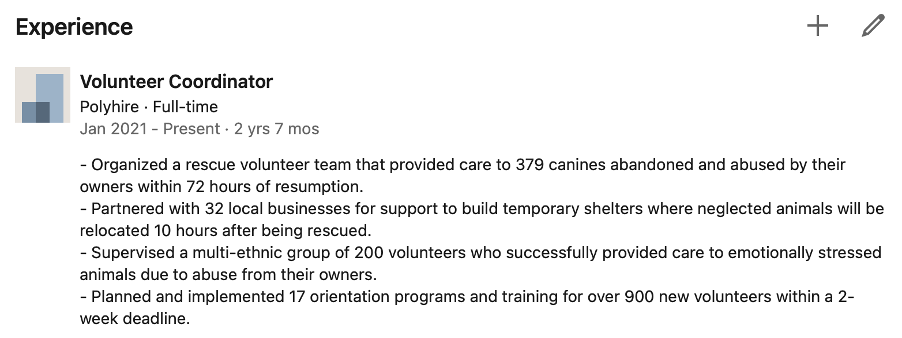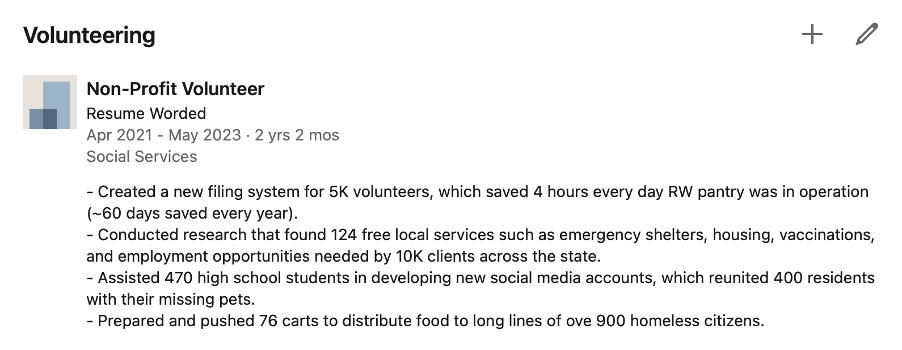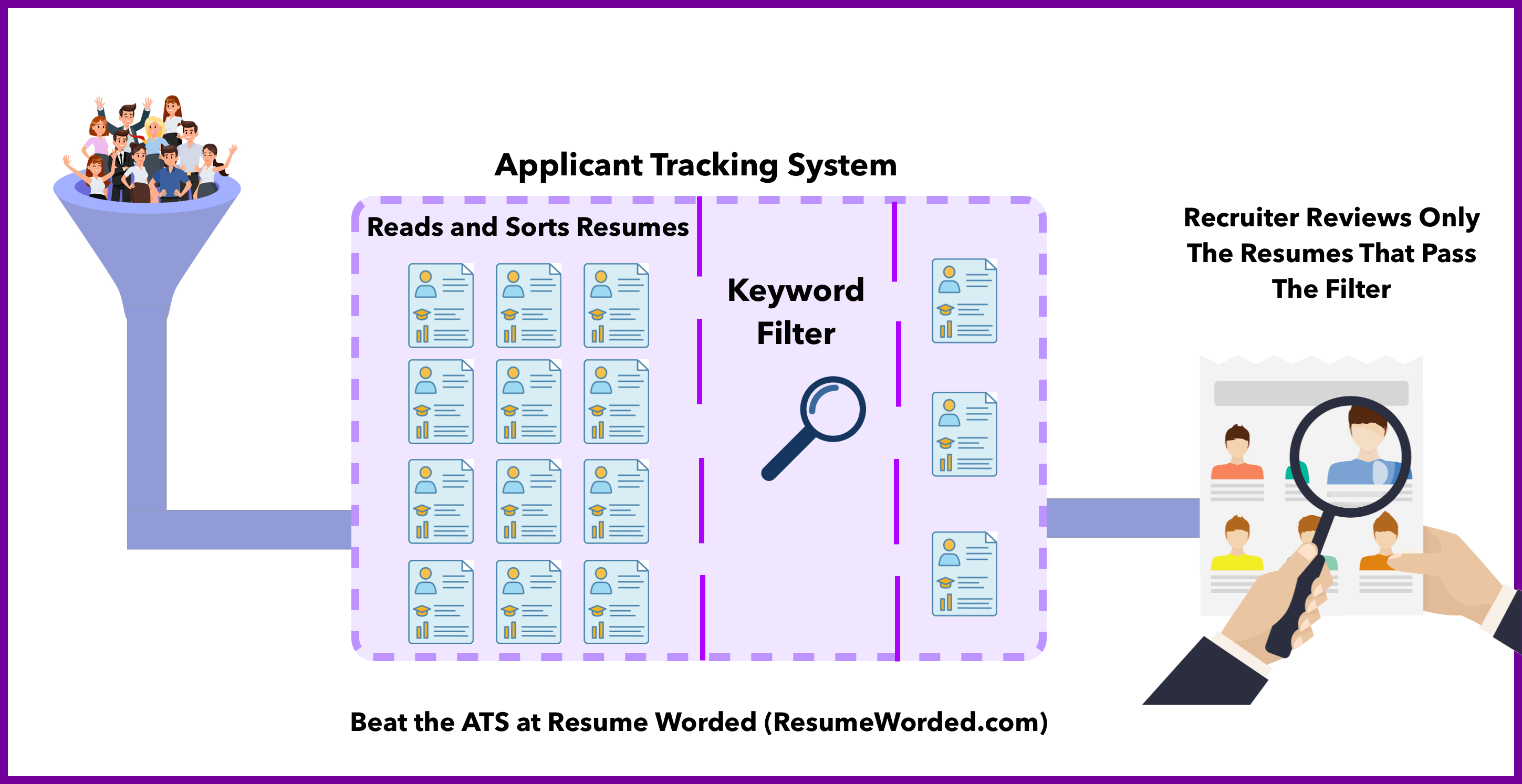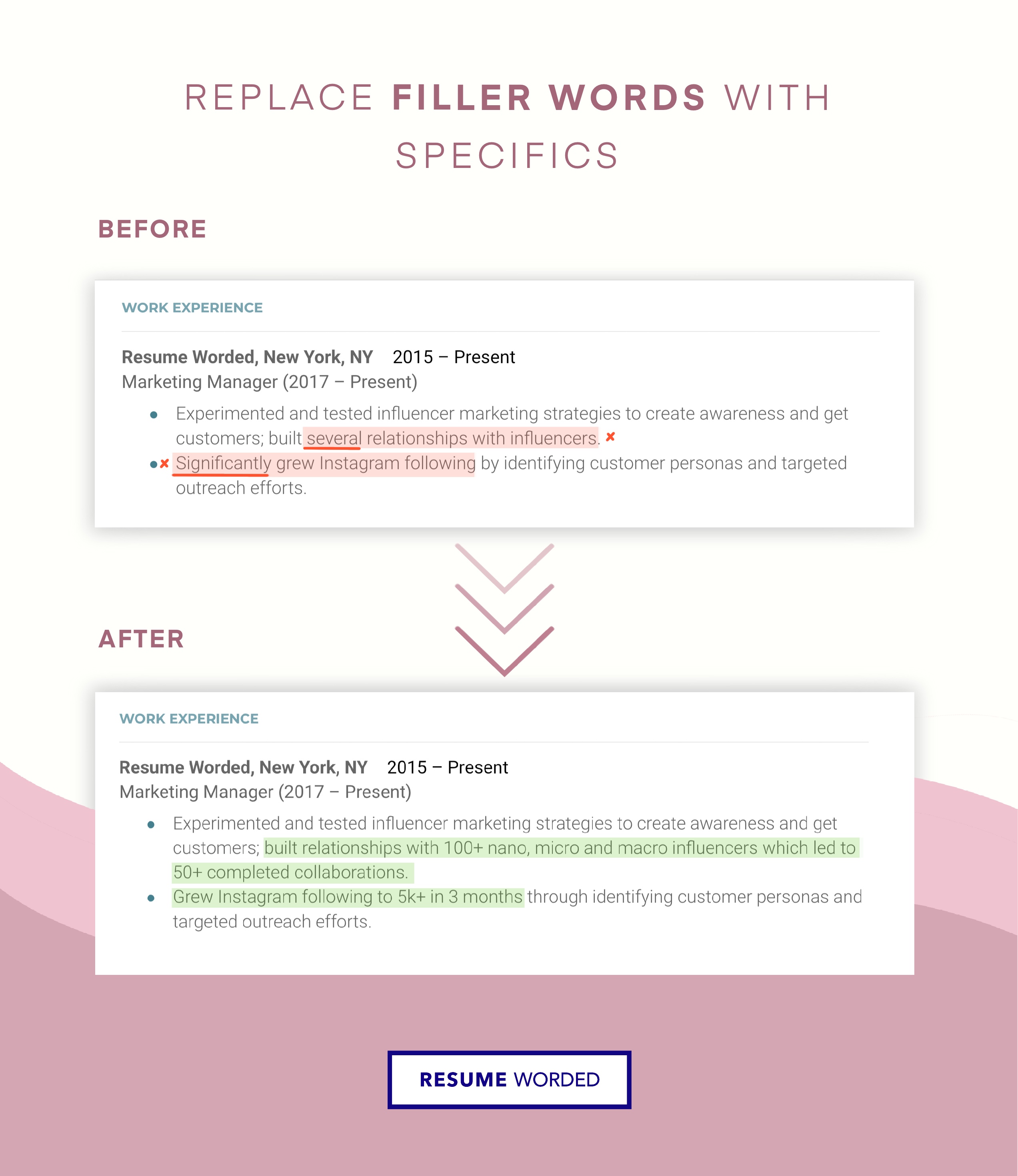Not all experience is created equal — but that doesn’t mean volunteer experience isn’t equally valuable. Whether you’re trying to gain more experience in your desired field or just enjoy helping out in your free time, volunteering is a great way to show potential employers that you’re active, engaged, and passionate about your line of work.
Keep reading as we talk about what makes volunteering LinkedIn-worthy, what type of accomplishments hiring managers want to see, and how to look for volunteer opportunities in your field. But first, let’s dive right into the nitty-gritty — how and where to put volunteer work on your LinkedIn profile.
Where to add volunteer work on LinkedIn
There are two places you should consider adding volunteer work on your LinkedIn profile: In your experience section and in a separate volunteering section.
How to add volunteer work to your LinkedIn experience section
If your volunteer work was significant enough, it’s fine to simply add it to your work experience section like you would any other job. This is a good option if you were a long-term volunteer with plenty of real accomplishments. It can also be used to pad out your work history if you lack paid experience in your chosen field or had a significant career gap.
Step by step:
- Go to your LinkedIn profile and click the + icon to add a new position.
- Use the name of the organization as your employer.
- Add your job title. If you didn’t have a specific title, it’s okay to use a clear job title that reflects what you actually did, like “Events Coordinator (Volunteer).”
- Specify the dates of your volunteer work — but make sure they’re accurate. If you volunteered on a seasonal basis, you can clarify this in your bullet points.
- Add 2-4 bullet points listing your main accomplishments. These should be formatted in the same way as your normal work accomplishments, with an action verb followed by what you did and what the results were — for example, “Planned and implemented 17 orientation programs and training for over 900 new volunteers within a 2-week deadline.”
Here’s an example of how this might look on LinkedIn:

How to create a volunteering section on LinkedIn
The customizability of LinkedIn profiles also means it’s easy to create an entirely new section for your volunteering experience.
Putting your volunteer work in a separate section means that it’s more likely to stand out, so do this if you really want to highlight it — for example, if you volunteered with a major organization in your field or you’re applying for work with nonprofits. It’s also a good option if you’ve volunteered with a number of different organizations.
Step by step:
- Go to your profile and click “add profile section.”
- Under “additional,” choose “add volunteer experience.”
- Enter the name of the organization, job title, and dates.
- Specify the type of organization you worked for under “cause.”
- Add 2-4 accomplishments in bullet points — more if it was a significant role and less if you want to add multiple volunteer positions.
Here’s an example of how your stand-alone Volunteering section might look on LinkedIn:

Tips for making your volunteer work stand out on LinkedIn
For your LinkedIn to be effective, it needs to make an impact with recruiters. Here are a few simple things you can do to stand out — in a good way.
- Feature volunteer work prominently. You can strategically reorder sections in your LinkedIn profile so that the parts you want to feature stay at the top, where they’re more likely to get noticed.
- Use action-oriented language. Just like on your resume, starting your bullet points with a strong action verb is a good way to make sure you’re focusing on your achievements, not your responsibilities.
- Quantify your impact. This is another great resume trick that works well for LinkedIn, too – using numbers wherever possible makes your accomplishments look more impressive (and genuine).
- Incorporate media and visuals. Try uploading some pictures from events or linking to videos showcasing the impact of your volunteer efforts. If you created anything as part of your volunteer work — like marketing materials or design work — you can directly link to those, too.
- Seek recommendations. More than skill endorsements, recommendations actually do carry weight with hiring managers. Request recommendations from colleagues, supervisors, or clients you worked with during your volunteer experience.
- Get professional advice. LinkedIn Review can give you instant, tailored feedback on how to improve your LinkedIn profile, including sections like volunteering.
Types of volunteer experiences to include on LinkedIn
The short answer is: Anything that’s relevant to the types of jobs you’re currently applying for (keep scrolling for advice on how to tell if it is). The long answer is: These are some (but not all) of the types of experience worth featuring on your LinkedIn profile.
- Community service. Any volunteer work you've done for local non-profits, charities, or community organizations.
- Professional associations. Volunteer roles or committee work you’ve done as part of your involvement with professional organizations in your industry.
- Leadership roles. Leadership is always worth highlighting — especially if you’re aiming at management positions or senior roles. Serving as a board member, team leader, or event coordinator in a volunteer capacity can be a good stepping stone even if you’ve never held a paid leadership role.
- Skills-based work. Even if the volunteer work was outside your field or job type, still include it if it allows you to demonstrate specific skills that are relevant to your chosen career.
- Industry-specific causes. If you're passionate about a particular cause, volunteering is a great way to show that. It’s also a good way to demonstrate genuine enthusiasm for an industry or cause if you’re new to the workforce or changing careers.
- Global or cultural experiences. Volunteering abroad or participating in cross-cultural programs demonstrates qualities that employers love, so don’t hesitate to highlight those experiences.
How to make sure your volunteering experience is relevant
Not all volunteer work may seem like it’s relevant enough to belong on your LinkedIn profile. Sometimes, relevance is obvious — like volunteering for an organization related to your target industry — but other times, it’s harder to tell. Here’s what to look out for:
- Transferable skills. Applying for jobs in marketing but don’t have any previous experience? Emphasize roles that allowed you to demonstrate creativity, communication, and problem solving skills.
- Desirable qualities. Take a look at your target job description. What does it say about the type of candidate they’re looking for? Volunteering is a great way to demonstrate otherwise vague attributes like being “passionate” or a “team player.”
The benefits of adding volunteer experience to your LinkedIn profile
Volunteering is a great way to give back to the community — but it can also benefit you professionally. Volunteer work can:
- Provide quantifiable achievements. If you lack relevant, quantifiable achievements in your work history — something all recruiters care about — you can add some through your volunteer work.
- Demonstrate transferable skills. Even volunteer work outside your industry can be relevant if you know how to spin it (scroll up for tips on how to do this).
- Create networking opportunities. Volunteering is a great way to meet like-minded people and get involved with professional organizations in your field.
- Bridge gaps in your work history. If you’ve had a long period of unemployment or other resume gap, filling it with volunteer work can help you avoid uncomfortable questions.
- Demonstrate cultural fit. Most employers aren’t just looking for candidates with the right background — they’re also looking for someone who’s a good fit. Volunteering is a great way to demonstrate outside interests as well as genuine passion and commitment to a cause.
How to find volunteer opportunities in your field
Want to volunteer but aren’t sure where to start? Here are a few tips:
- Research your target industry. Before selecting volunteer experiences, research your target industry or the specific roles you're interested in. Look for volunteer opportunities that align with the skills, knowledge, and values sought after in those fields.
- Ask your contacts. Reach out to friends, colleagues, or professional contacts in your target industry to see what organizations or types of work they recommend.
- Search LinkedIn. LinkedIn isn’t just a great place to find paid jobs — it can also help you find volunteer experiences, too. Try joining one or two groups in your area or industry to get involved.









